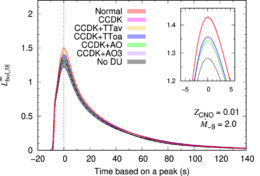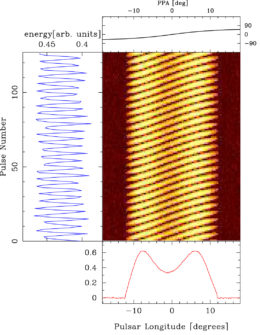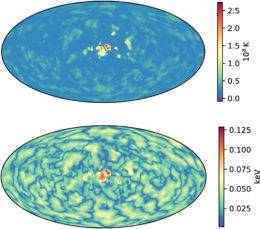When a massive star explodes as a supernova, its core collapses into a city-sized sphere of neutrons called a neutron star. These extraordinarily dense stars — just one teaspoon of a neutron star would weigh billions of tons in Earth’s gravity — exhibit some of the most intriguing behavior in the universe: rapid rotation, beams of radio emission, and extremely strong magnetic fields. Today, we’ll introduce four recent research articles that explore different aspects of these stars.
Bursting, Cooling, and Bursting Again

Simulated light curves during an X-ray burst, showing the effects of incorporating different physics. A model without neutrino cooling (labeled “No DU” in reference to the neutrino cooling pathway called direct Urca), peaks at a lower luminosity than models incorporating neutrino cooling. [Adapted from Dohi et al. 2022]
In a recent publication, a team led by Akira Dohi (土肥明; Kyushu University, Japan) explored the issue of neutron star cooling with general relativistic stellar evolution models. Specifically, the team investigated the effects of cooling by emitting neutrinos — chargeless, nearly massless particles that scarcely interact with matter — which is expected to speed up the cooling rate. The authors found that neutrino cooling increases the time between outbursts but makes them brighter at their peak, though additional physics to be included in future modeling might suppress this effect.

Simulated pulses showing a change in the phase of the pulse due to the shifting motion of the sparks. [Adapted from Basu et al. 2022]
Simulating Pulsar Sparks
Rahul Basu (University of Zielona Góra, Poland) and collaborators reported on simulations of conditions very close to the surface of a neutron star that emits beams of radio emission. Neutron stars that emit beamed radio waves are called pulsars for the way the beams sweep across our field of view, generating what we see as pulses of emission. Near a pulsar’s surface, extremely high temperatures and strong magnetic and electric fields combine forces to summon a sea of charged particles that are then accelerated to relativistic speeds.
Basu and collaborators focused on a phenomenon called sparking, in which charged particles jump the gap between the pulsar’s surface at its poles and its plasma-rich magnetosphere. The team’s modeling demonstrated that a pulsar’s poles are tightly filled with constant sparks, and the arrangement of these sparks slowly shifts over time. By modeling the emission associated with the simulated sparks, the team showed that the shifting motion of the sparks appears to be responsible for the observed periodic variations in the phases and amplitudes of some pulsars’ pulses.
Pulsars Probing Gravitational Waves

Example of a pulse observed with the Giant Metrewave Radio Telescope. [Adapted from Sharma et al. 2022]
However, there’s a complication to this technique: spatial and temporal changes in the interstellar medium plasma can also affect when a pulsar’s radio pulses arrive at Earth. In order to compensate for the effect of the interstellar medium, we need to be able to make precise observations of pulsars across a range of radio frequencies. In a recent research article, Shyam Sharma (Tata Institute of Fundamental Research, India) and collaborators tested a pulsar-timing measurement technique using the Giant Metrewave Radio Telescope, which is highly sensitive to low-frequency radio waves. Sharma and coauthors showed that observing using a wide frequency band yields results comparable to typical narrowband observations, indicating that this technique could be used to disentangle the effects of the interstellar medium and more accurately time the pulses of arrays of pulsars, opening a new window onto gravitational waves.

Temperature maps of the top of a magnetar’s crust (top) and the magnetar’s surface (bottom) after a hotspot is injected. [De Grandis et al. 2022]
Magnetic Outbursts
As if neutron stars could get any wilder: some neutron stars, dubbed magnetars, have extremely strong magnetic fields and exhibit frequent X-ray flares. While the cause of these X-ray outbursts is still unknown, some researchers have suggested that they arise from a sudden upwelling of magnetic energy beneath the magnetar’s crust, creating a hot spot that cools gradually over days or months.
To understand how the injection of heat into a magnetar’s crust might create the spectral features seen during X-ray outbursts, Davide De Grandis (University of Padova, Italy) and coauthors employed a three-dimensional magnetothermal model of hotspot formation and cooling. This model allowed the team to study the effects of asymmetrical hot spots under a magnetar’s crust for the first time. The team was able to confirm that these hot spots can be responsible for outbursts, though we’ll have to wait for future research to fully explore the evolution of the spectral features generated during these events.
Citation
“Impacts of the Direct Urca and Superfluidity inside a Neutron Star on Type I X-Ray Bursts and X-Ray Superbursts,” A. Dohi et al 2022 ApJ 937 124. doi:10.3847/1538-4357/ac8dfe
“Two-dimensional Configuration and Temporal Evolution of Spark Discharges in Pulsars,” Rahul Basu et al 2022 ApJ 936 35. doi:10.3847/1538-4357/ac8479
“Wide-band Timing of GMRT-discovered Millisecond Pulsars,” Shyam S. Sharma et al 2022 ApJ 936 86. doi:10.3847/1538-4357/ac86d8
“Three-dimensional Magnetothermal Simulations of Magnetar Outbursts,” Davide De Grandis et al 2022 ApJ 936 99. doi:10.3847/1538-4357/ac8797

